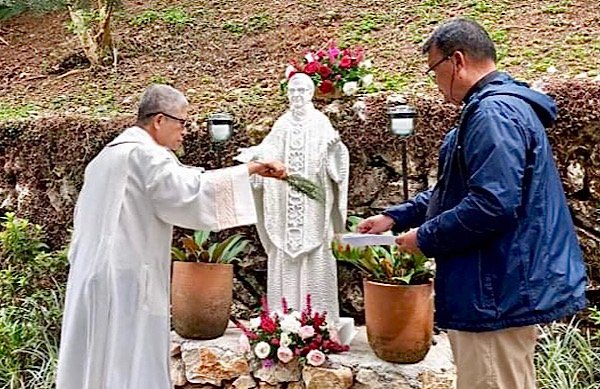A statue of St. Josemaria Escriva, founder of Opus Dei, joined a row of fellow saints who have founded various spiritualities within the Catholic Church, in the Garden of Saints of the Mirador Jesuit Villa and Retreat House in Baguio City. The Regional Vicar of Opus Dei in the Philippines, Msgr. Carlos Estrada, was present to officiate the blessing of the statue on April 2, 2022.
Father Jose Quilongquilong, former Rector of Loyola House of Studies and now Administrator of Jesuit Retreat Villa and Eco-Spirituality Park in Baguio, opened the event thanking Msgr. Estrada for coming to bless the statue. He shared that the Garden of Saints was completed just two weeks earlier.
The simple ceremony commenced with a description of the Garden of Saints, an area of reflection and prayer where statues of the Virgin Mary and saints are the centerpieces. Many of the saints are patrons of things related to nature. The introduction read by Msgr. Estrada noted that St. Josemaria’s “proclamation on the universal call to holiness and apostolic work certainly reminds us of the call to stewardship of God’s creation which our first parents received in the Garden of Eden as described in the Book of Genesis.”
The gospel read was St. Luke’s account of the miraculous catch of fish, which prompted Simon Peter to exclaim, “Depart from me, Lord, for I am a sinful man.” Jesus said in reply, “Do not be afraid, from now on you will be catching men.”

In his brief homily, Msgr. Estrada reflected on the significance of the Garden of Saints. “The garden reminds us that we are all called to holiness, whatever spirituality we follow or whatever path God calls us to.” He recalled that in 1967, St. Josemaría preached a homily (later published with the title, “Passionately Loving the World”) in the open air, with the buildings of University of Navarre still under construction as backdrop, a setting that was analogous to the Garden of Saints now.
“Everything that God created is good and can be lifted up to Him,” Msgr. Estrada said, recalling the core message of that homily. “Heaven and earth seem to meet in the horizon, but where they really meet is in our hearts,” he said, paraphrasing Saint Josemaria.
“Something similar happens here,” he continued. “When persons come for a retreat or reflection, they have heaven very close in the sense that they are up on a hill, on firm ground with the saints. They can reflect on the witnesses of the saints who in various ways have learned to unite the material and the spiritual. Pilgrims or retreatants can look forward to that moment when they hopefully will be with all the saints in heaven, with feet planted firmly on the ground as they carry out the mission to lift up everything to God and not to separate this world from what God wants them to carry out here on earth.”

The Mirador Jesuit Villa and Retreat House is a resplendent space for prayer, seated atop Mirador Hill. On a clear day, the site affords a 360-degree view of Baguio City and beyond. Encouraged by the American colonial government at the turn of the 20th century, the Jesuits and other religious groups established houses in Baguio. The Jesuits got the Mirador Hill property. Following Padre Faura’s pioneering work of tracking typhoons and earthquakes in Manila, they set up a meteorological-geodynamic observatory on this strategic site.
The newly opened Mirador Heritage and Eco-Spirituality Park is a nine-hectare site for pilgrimages and contemplation, which allows visitors to get immersed in nature. People can pray and reflect as they walk amid trees, bamboo, flowering plants, statues of saints, and religious images embedded in caverns and rock formations.

Msgr. Estrada capped the ceremony with a prayer: “O almighty, everlasting God. Thou dost approve of the sculptured or painted images of thy saints, in order that when we behold them, we may be led to contemplate and imitate their lives and holiness.”
Statues in the garden include those of St. Ignatius of Loyola, St. Dominic, St. Padre Pio, St. Francis of Assisi, St. Catherine of Siena, San Isidro Labrador, San Roque, and St. Benedict of Nursia, among many others.
